
16-18 April 2015. In Australia’s Northern Territory there are three Alligator Rivers: the East Alligator River, the West Alligator River, and the South Alligator River. There are no alligators in Australia. An early explorer, who named the rivers, apparently mistook the crocodiles for alligators and the names stuck. For the record, and among many other details, crocodiles have a pointier jaw, and both upper and lower teeth show when their mouth is closed. Smiling crocodiles. Is that an oxymoron? Alligators have a rounded jaw and their lower teeth are hidden when the mouth is closed. Something I’ll be sure to look out for next time I come in close contact with one. Just to confuse matters further both are crocodilians.
We want to go to Arnhem Land but the road is impassable. You must cross the East Alligator River, full of crocodiles, which forms the boundary between Kakadu National Park and Arnhem Land, and it is still flooded from the wet season.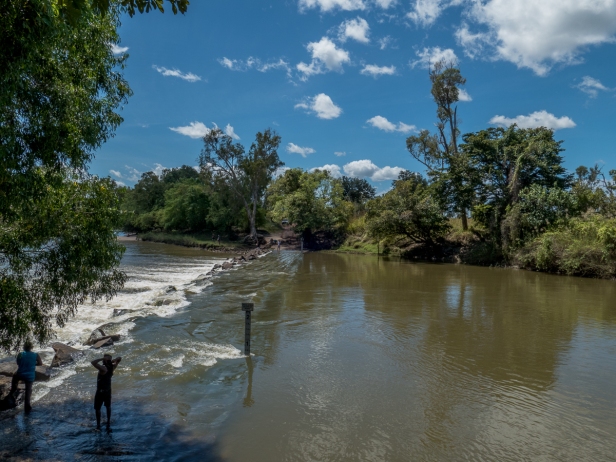
We see 4WD vehicles on either side waiting for the water level to drop enough to make it safely across. Any day now. Are they camped out or do they think it will drop enough sometime today? We decide that our little sedan is more likely to be swept away than make it to the other side. Besides, since Arnhem Land is an Aboriginal Reserve a permit is needed to enter and we don’t have one.
Instead we take a cruise in an open boat up the East Alligator River.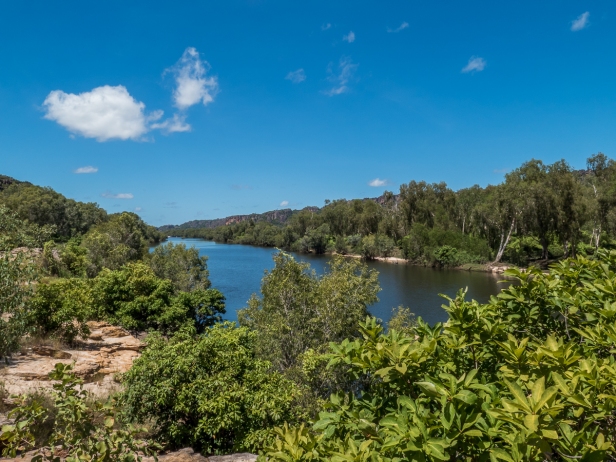

Our guide’s name is Mahdahnyia, although he calls himself Neville for non-Aboriginal people. It’s easier to pronounce.
As we cruise along he tells us there are three to four thousand crocs in the East Alligator River, and that he’s seen as many as one hundred and fifty on the banks during the dry season cruises. During the wet season the water rises by several metres as the area is drenched with 1.5 metres of rain in a three-month period. During this time much of the land is flooded and the crocodiles spread out with the water.
The horizontal branch in this tree shows the depth of the water at the height of the wet season.
As we cruise along, Mahdahniya tells us about Arnhem Land, one hundred thousand square kilometres, twenty thousand people, fifty different languages. He is teaching his children the traditional ways of the bush, hunting, fishing, how to make spears, how to find food. They speak English at school but use their own language at home.
He points out wild figs, and tells us their spears are made from native hibiscus because they have very straight branches, and the tips are carved from ironwood. He shows us how to make a paintbrush from pandanus root, and a water dipper from the soft and malleable waterproof bark of a tree.
There are pandanus growing on the banks with their roots going down into the river, and also on higher ground in other parts of the park.
We pull over to the Arnhem Land side of the river and get out. We actually get to Arnhem Land, even if only briefly.
While we are there Mahdahniya shows how a woomera is used to launch a spear with far greater force and distance than would be possible without it. The spear sits perfectly into the end of the carved wood, which is used to hurl it. When he throws it the spear goes flying clear across to the middle of the river. No kangaroo, or rock wallaby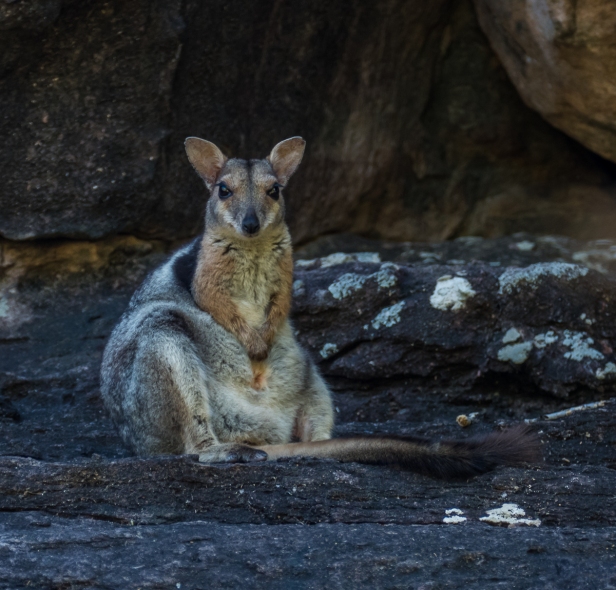
could possibly survive the force of such a weapon.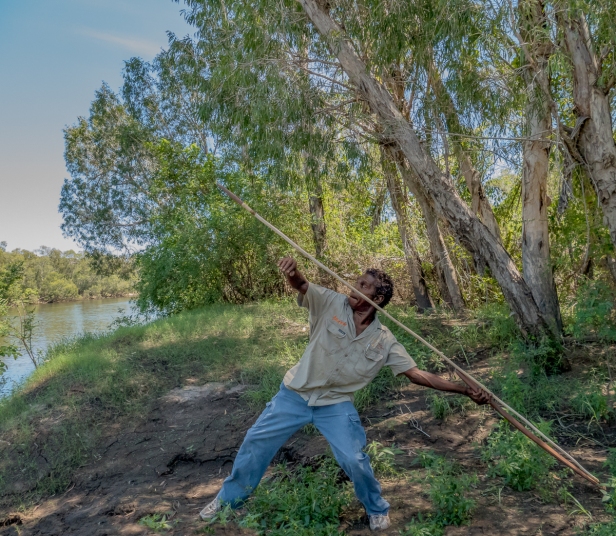
By rubbing two small orange rocks together with a little water, Mahdahniya makes paint, and taking the pandanus paintbrush slowly and deliberately paints the image of a warrior spirit on his arm. He is visibly moved.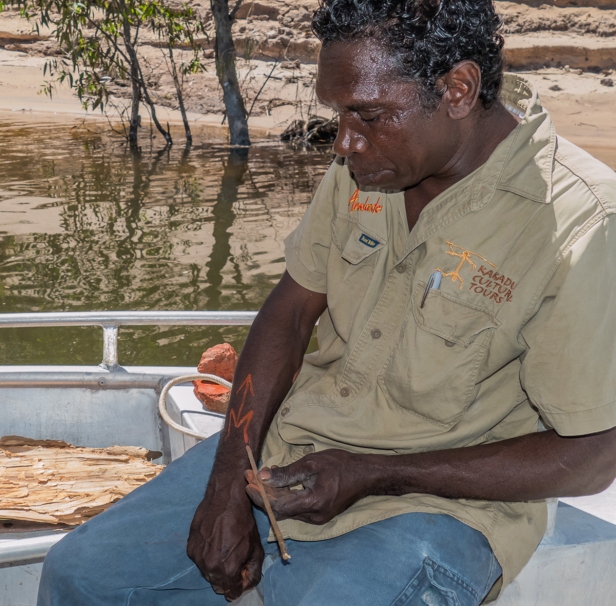
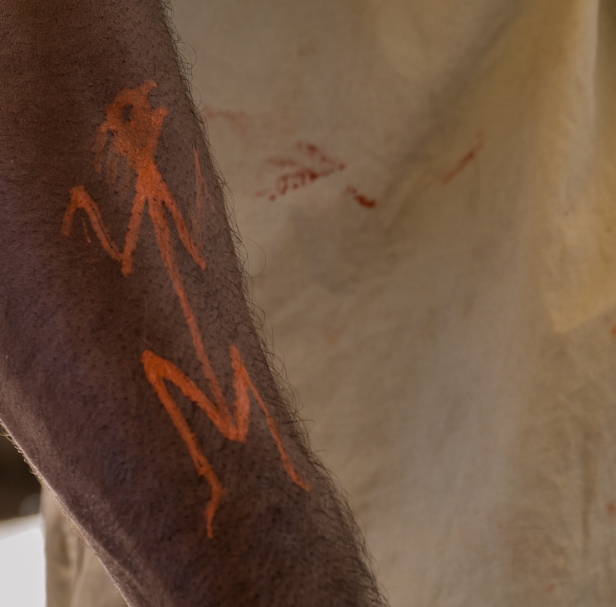
Kites fly overhead in the hot silent stillness.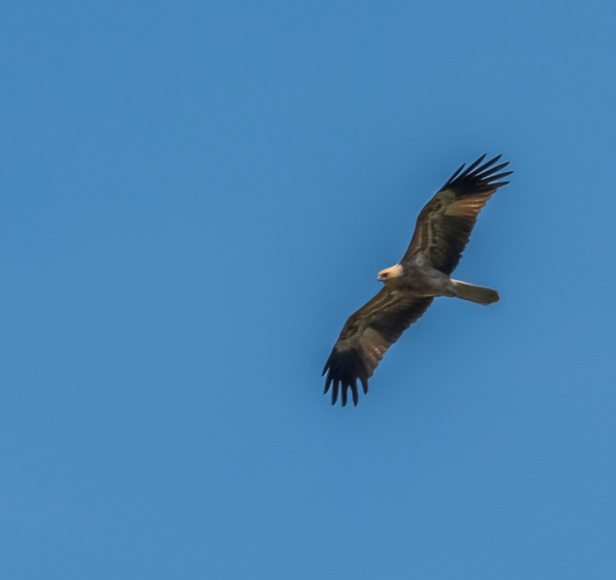
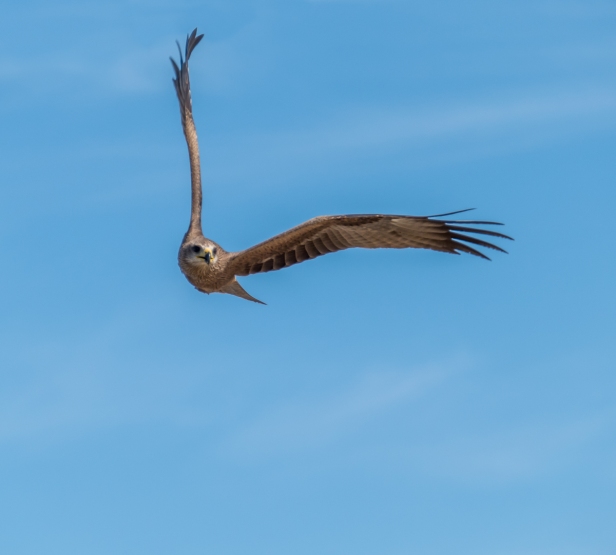
Aboriginal people have occupied the Kakadu National Park area and the adjacent Arnhem Land Aboriginal Reserve continuously for at least forty thousand years. They are the oldest living culture on earth. Today the traditional owners of the land are descendants of the original clans of the area and manage the park in partnership with Parks Australia, playing a key role in Board decisions and hands-on management. Much of the park has been returned to Aboriginal ownership and the rest is in the land claims process.
The name Kakadu comes from the Aboriginal word gaagudju, which is the name of a language that was formerly spoken in the northern part of the park.
There are five thousand recorded art sites within Kakadu National Park illustrating Aboriginal culture throughout the millennia. The oldest of them are more than twenty thousand years old. It is a rich and irreplaceable heritage of human activity. We visited three of the main sites: Nanguluwur, Anbangbang, and Ubirr. All three sites have dwellings of various sizes, overhanging slabs of rock, where the people sheltered during the wet season. One was easily big enough, and protected enough, to house up to fifty or sixty people.
From the Nanguluwur site: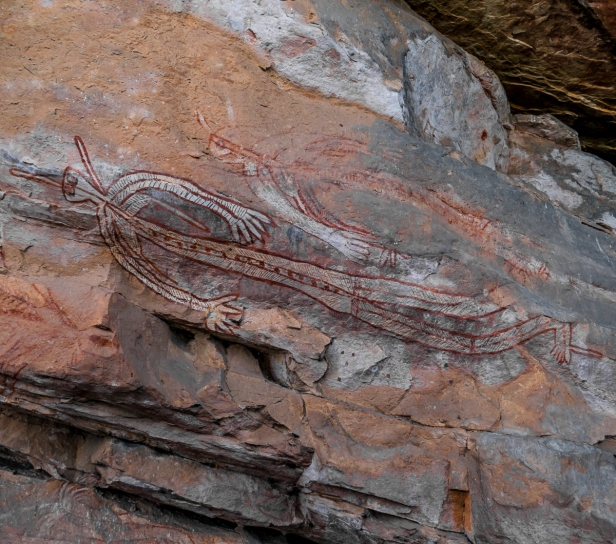
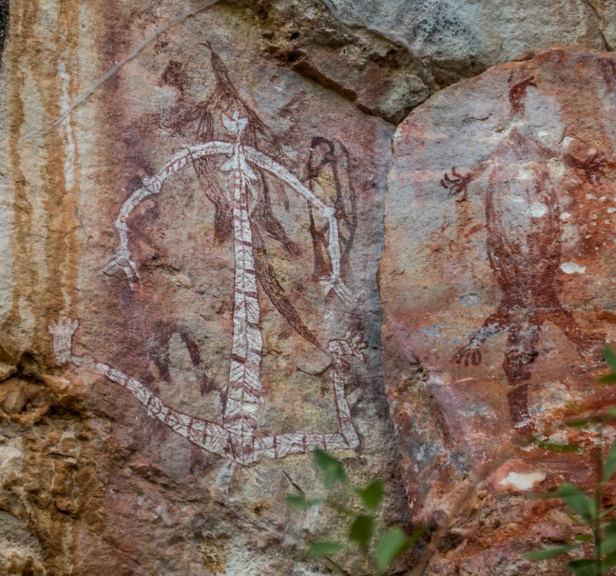
The frieze of fish and turtle is an excellent example of x-ray style art. Notice that the organs of the animals are included in the paintings.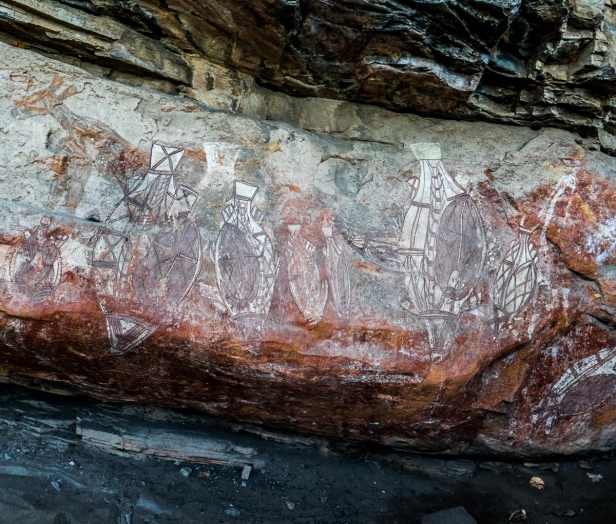
Algaihgo (pronounced Al-guy-go), the fire woman, is one of the First people, or Nayuhyunggi, who created the world. She planted the yellow banksias in the woodlands and used their smouldering flowers to carry fire.
Stories about Algaihgo tell how she hunted rock possum, her favourite food, with the help of the dingoes who travelled with her.
People are afraid of Algaihgo, because she kills and burns people, and avoid her Djang (sacred site) on the Arnhem Land Plateau where her spirit lives.
Algaihgo is the one with four arms and flames coming out of her head.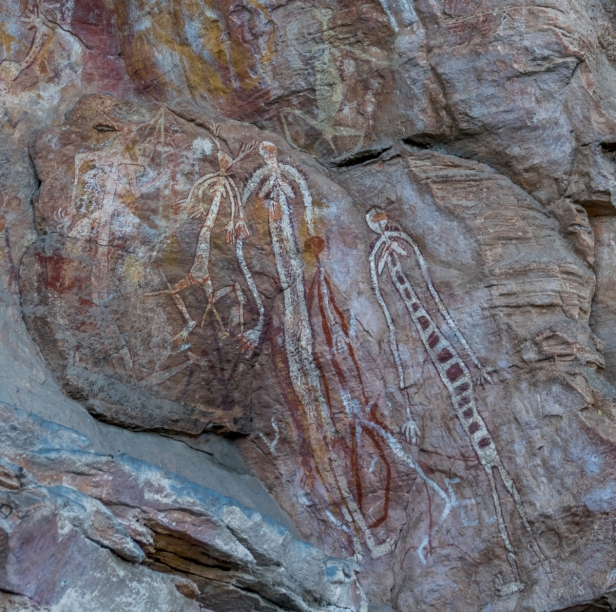
A sign at Anbangbang tell us this: We live privately elsewhere in the park and leave this place for visitors to see now.
As our people visited and sheltered here in the old days, they hunted meats, gathered fruits and vegetables, shared food, played games, told stories, painted pictures, and sometimes performed ceremonies. The gunbim (rock art) in the shelters is left as evidence that this place has traditionally been a place of living and learning.
A quote from Violet Lawson – Murrumburr Clan, about Anbangbang
That’s a place where people sheltered from the rain in Gudjewk (monsoon season). A place for making tools, telling stories, doing string games while the tucker is cooking. Go hunting down the river, when the water goes down a bit. Hunting yams, kangaroos, and sugarbag. Waiting around til the dry season comes. Today we got house and still cook galawan (sand goanna) on the coals of open fires.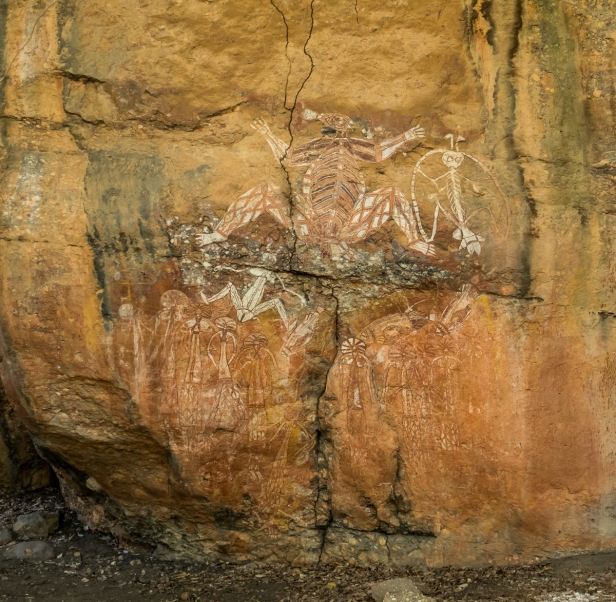
This is Nabulwinjbulwinj. He is a dangerous spirit who eats females after striking them with a yam.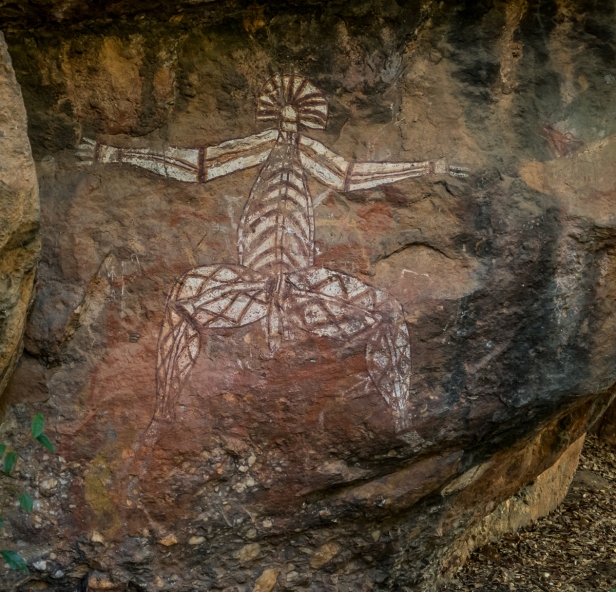
From a sign at the Ubirr Art site: A lesson in Good Behaviour. This painting of Mabuyu reminds traditional owners to tell a story which warns against stealing.
Mabuyu was dragging his catch on a string after a fishing expedition when a greedy person cut the string and stole his fish. That night Mabuyu waited until the thieves had eaten his fish and were camped inside their cave near the East Alligator River. “Then he blocked the cave with a huge rock. Next morning they never came out. Because they pinched it they got punished. Kids, ladies, and men all dead – finished.” . . . . Bill Neidjie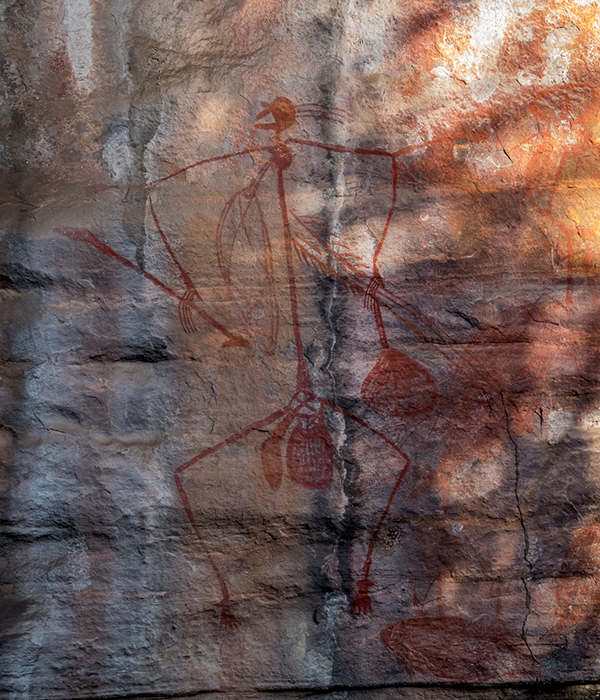
The bones of this person have been swollen by Miyamiya, a sickness you can contract if you disturb the stones of a sacred site downstream near the East Alligator River.
One of the reasons Aboriginal people are so concerned about protecting their sacred sites is that some sites, if disturbed, are considered to be extremely dangerous for everybody.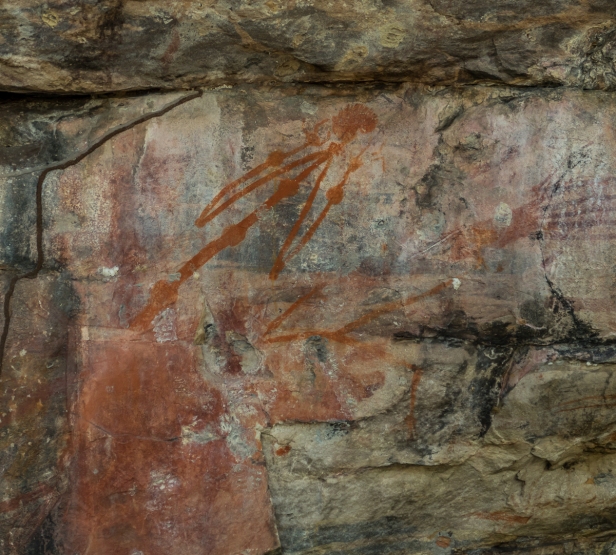
We visited just three of five thousand sites. There is widespread evidence of Aboriginal occupation throughout Australia. I remember in my twenties, when I lived in the far north-west in the small coastal mining town of Dampier, when out hiking I would frequently find Aboriginal rock art, un-noted, unheralded, a natural part of the rocky desert landscape and taken for granted.
For forty thousand years the Aboriginal people have been part of this earth, living in deep harmony with their natural surroundings. Left to their traditional ways there is no separation between them and the land. They know all the secrets the land, the plants, the animals have to offer, and nothing is done without honour and reverence. Everything is respected and everything is sacred.
From the top of the escarpment at Ubirr, looking out over the valley, green from the wet season rains:

The land is rich with flowers like this grevillia,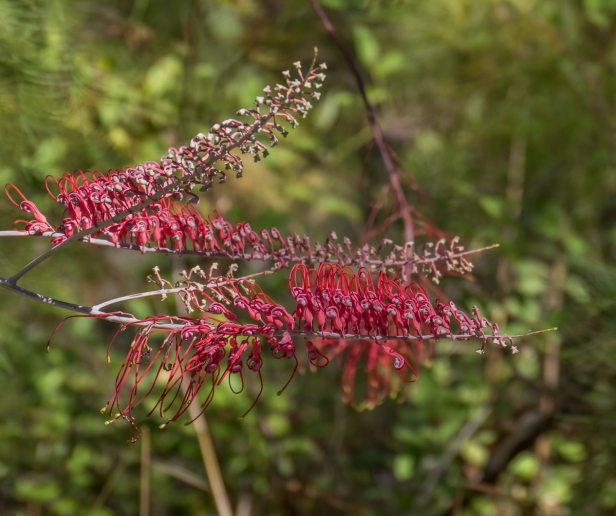
and dancing dragonflies.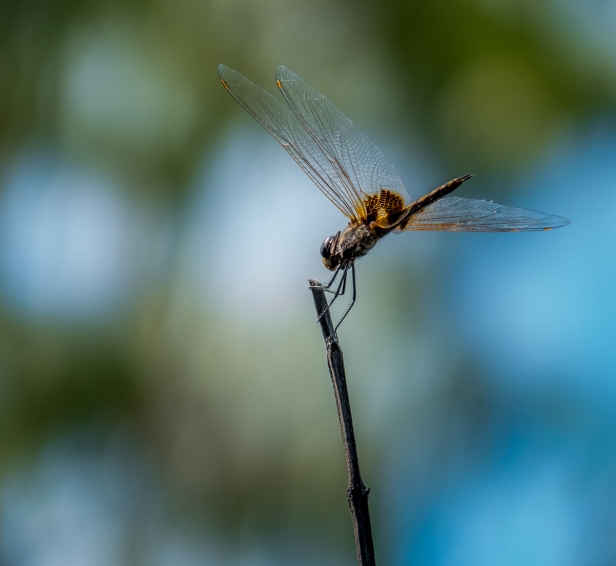
Where there is dry ground we see the giant mounds of grass-eating termites.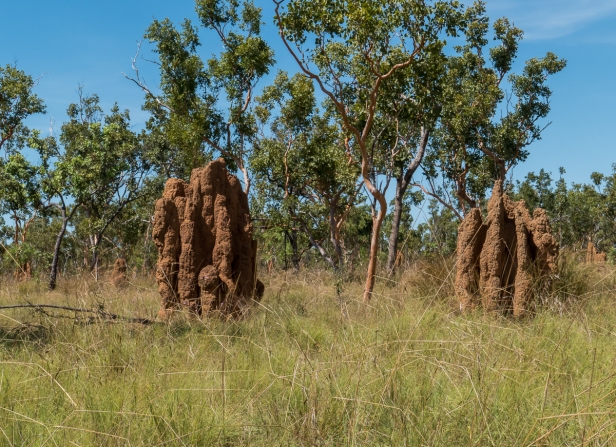
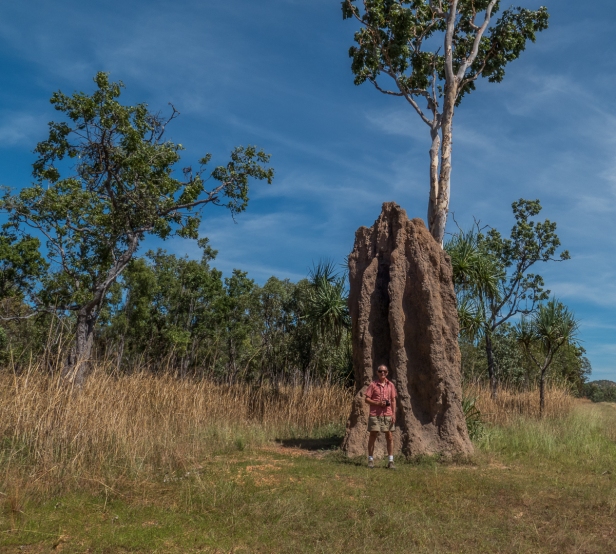
And where the wet season has flooded the land we see water filled with lilies and egrets,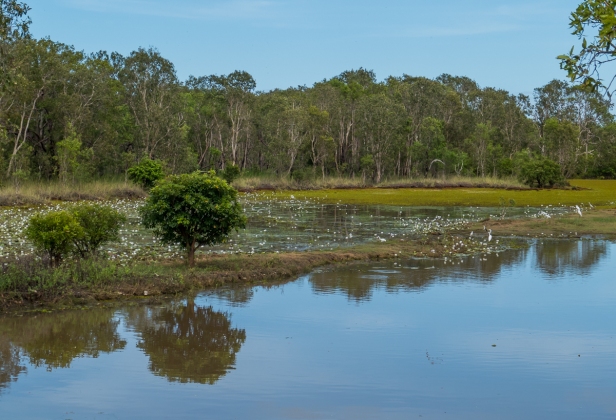
and a pair of brolgas, the native Australian crane.
We only saw a small portion of Kakadu. Much was still closed to the public due to flooding making the roads impassable, and due to the presence of crocodiles. What we did see is magnificent. An ancient culture and an ancient land: powerful, mysterious, and eternal.
Next post: the boundaries of the park are artificial lines on the map. Australia’s Top End is vast and empty. Our exploration continued as we headed south – fruit bats, pythons, hot-water rivers, deep gorges, cascading pools, and Mindil beach at sunset.
All words and images by Alison Louise Armstrong unless otherwise noted
© Alison Louise Armstrong and Adventures in Wonderland – a pilgrimage of the heart, 2010-2015.

What a stunning place & photos!
LikeLiked by 1 person
Thanks Cindy. Yes, a stunning place!
Alison
LikeLike
fascinating and informative – great pictures!
LikeLiked by 1 person
Thanks Jo Ann. We loved it, the place, the people, the culture. A very rich history.
Alison
LikeLike
Stunning and amazing ! Beautiful photos and great informatively written. Thank you for sharing this pleasant read!
LikeLiked by 1 person
Thank you so much Francina. I’m glad you enjoyed it. We had an amazing time there and really enjoyed learning about the Aboriginal culture in a part of the country where it still lives.
Alison
LikeLike
Must have been incredible indeed to be there, Alison. I have read a lot about it, but that is not the same as seeing it with your own eyes. Groetjes, Francina
LikeLiked by 1 person
I love rock art, as you may remember. I would come to Australia for that reason alone! Thanks for the tour, Alison. –Curt
LikeLiked by 1 person
I do remember, and I thought you might enjoy this post. Oz is worth visiting for many reasons, but the rock art is just about as old as time, and readily available in places like Kakadu and Arnhem Land. It’s not hard to get a permit to visit Oenpelli in Arnhem Land, and I think there’s more rock art there. You should go visit! 🙂
Australia
LikeLike
Yes! I showed Peggy the photos. She was as impressed as I was. –Curt
LikeLiked by 1 person
i felt a deep compassion
for the aboriginal peoples
and sacred space
conveyed
in these words
& images 🙂
LikeLiked by 1 person
They lost so much
white man invasion
but in communities around the land
retain their sacred ways
especially in the north.
The feeling that the land
itself is sacred
fills me there.
Alison
LikeLike
What a fascinating area! How long were you in this part of the country overall? It seems like you could explore there forever! We did not make it up north – will have to go back for that and so much more in your native land.
LikeLiked by 1 person
Oh yes, it is most fascinating. We loved it! We were in the Top End for 16 days, and there will be posts to come on Nitmiluk (Katherine Gorge), Litchfield National Park, and Mataranka Springs and Bitter Creek – all fabulous places. Neither of us had been to that part of the country, and we’re very glad we went. And yes, you could explore forever!
Alison
LikeLiked by 1 person
I read a book called “Walkabout” by James Vance Marshall when I was still in junior high school and have been fascinated by the Aboriginal people and their culture since. It’s good to know that a portion of their traditional lands have been restored to them outright and that their other claims are being considered. So fascinating to see your photos of some of the vast parkland and learn more about the myths and traditions of these people and their descendants. They have much to take pride in. Anita
LikeLiked by 1 person
I suspect I may have read Walkabout way back in my childhood but don’t remember it. We were taught about Aboriginal culture in school of course, in a very patriarchal and white-washed way. The land claims struggle has been long and hard fought, and is ongoing, but there has been progress. Aboriginal presence and culture is strong in the north, as is racism I gather but I didn’t see it.
Alison
LikeLike
A sad parallel to the Native American story in the US and Canada …
LikeLiked by 1 person
These photos are just stunning. I must see for myself the light in this part of the world. My daughter has traveled far and wide, and though she didn’t get to Australia, she did spend months in NZ. Her photographs and remarks about the atmosphere there compel me to want to go one day. Thanks for your story as well. You are most fortunate to enjoy the company of such a guide. Blessings!
LikeLiked by 1 person
Thanks so much Bela. The light is gorgeous! Also is just as beautiful in NZ.
We were lucky to have such a guide, with so much knowledge and deep connection to his culture and to the land. Do go – it’s a wonderful part of the world!
Alison
LikeLiked by 1 person
Stunningly beautiful photos and stories. Loved it all so much.
LikeLiked by 1 person
Thanks so much Ros. I’m so glad you enjoyed it. It’s a stunningly beautiful part of the country. Our whole time in the north stands out as a highlight of our travels.
Alison
LikeLike
A great post giving an insight into the amazing culture of the Aboriginal people. I never thought much about them until we travelled up north and through WA and central Australia and started to learn about their culture. It is such a shame that the pioneers almost decimated this culture instead of learning from them.
LikeLiked by 1 person
Thanks pommepal. It’s only when you get away from the cities and into the outback that you come across the Aborigines and their beautiful rich culture. They know the land so well, but of course invaders did what they do everywhere and throughout time. As Anita said above, it’s a sad parallel to the way Aboriginal peoples were treated in North America.
Alison
LikeLike
Europeans have a lot to answer for all around the world.
LikeLiked by 1 person
Man, that is one scary giant termite next to the mound!! I have to agree with Pommepal, too bad those guys in those days had so little respect for other people. They (the same people) did the same thing to the Native Americans. Gone. A whole civilization.
It looks like you are doing something different to/with your photos? Still very cool, and excellent, but a little different. Maybe it’s just a dark sky? You caught the birds well!
LikeLiked by 1 person
Yeah, I’d say he’s pretty scary 🙂
So sad that indigenous cultures routinely get almost decimated by invaders. It applies in Mexico and South America too, and many other places. Suddenly I’m thinking of Hawaii where the native culture has become a tourist attraction.
Not aware of doing anything different with photos – maybe it’s the place, the light?
Alison
LikeLiked by 1 person
Right. Scary character.
Globalization is good and it is bad. We move on, I guess.
Photos: probably just the light!
LikeLiked by 1 person
Those giant termite mounds totally squick me out! But the beautiful pictures of the birds and the landscape more than make up for it. I am so glad you’re sharing some of the Aboriginal artwork – it’s much more fun reading about it from you than in a boring history book. 🙂
LikeLiked by 1 person
Those giant termite mounds are not covered in termites though you can see little holes where they come and go. Some of them have been dressed in T-shirts and caps 🙂 (should have gotten a picture of that!)
The Aboriginal art work is pretty amazing, and I loved the stories that go with them.
Alison
LikeLike
You know, I never did learn the difference between crocodiles and alligators till now. 😀 So thank you for that and for sharing the rest of your wonderful experience.
LikeLiked by 1 person
Thanks SGMT, glad you enjoyed it, and that you are now educated re crocs and gators 🙂
Alison
LikeLike
What a beautiful place so full of culture and art. Thanks for taking me ther Alison!
LikeLiked by 1 person
Thanks Nicole. And you’re welcome!
Alison
LikeLike
Great lovely.Please have a look on my blog too.I hope you will like my posts.
LikeLiked by 1 person
Thank you so much Prajjwal. I will be sure to pop over to your place soon.
Alison
LikeLiked by 1 person
Thanks for your kind response.
LikeLiked by 1 person
The guide was wonderful – how many times has he explained uses of plants, seasonal changes in the land, to tourists? Yet he shares his knowledge patiently. I suppose it’s also a living, but in the end, we have much to learn from that ancient culture.
LikeLiked by 1 person
Yes, the guide was wonderful! We loved that river trip. He seemed to be very much at peace with his life. He gets to live on the land, and to live the old traditional ways, and to share it with others. It was all fascinating.
Alison
LikeLike
When I saw the amazing light in your first photo, I knew this would be a magical post. Nicely done.
LikeLike
Thanks so much Marsha. It is a magical place that’s for sure.
Alison
LikeLiked by 1 person
Hi Alison, your first sentence made me laugh. Aboriginal art and culture is fascinating and I do hope their tradicional way of life will survive. It would be great if visitors to their land could respect and honour their sacrad sites. Beautiful pictures, do you use photoshop at all?
LikeLiked by 1 person
Thanks so much Gilda. I’m fairly confident that the traditional ways of the Aborigines will survive, at least to some extent, in the northern part of Australia. In the more populated areas not so much. People these days mostly do honour their sacred sites, or else they are closed to the public. Sadly there are still a few people who choose to climb Uluru (Ayers Rock).
Yes I use both Lightroom and Photoshop. I find they’re amazing tools for making the photo look like what I actually saw.
Alison
LikeLike
Wonderful photography. Combined with your descriptions it’s almost like being there! An amazing and unique land to explore. I didn’t realize how old the culture is and how many artifacts there are describing ancient times. Thank you for sharing.
LikeLiked by 1 person
Thank you so much Eileen. Yes, it certainly an amazing and unique land. Neither of us had been there before and we both found it to be a really special part of the world. The Aboriginal culture is the oldest surviving culture on earth. It’s pretty amazing that it’s somehow survived, at least in places, considering what’s been done to them. Glad you enjoyed the post.
Alison
LikeLike
Really beautiful photos. Perhaps it was the subject matter at hand tainting my interpretation, but that first one just struck me as a window to a timeless creation. That image could have been 40,000 years ago… or yesterday.
I think I was most touched by your description of Neville’s painting of a warrior spirit on his arm, and how he was “visibly moved”. This sacred something that moved him– that strikes me as the difference between the conquering cultures and the conquered. The conquering haven’t known how to acknowledge or witness that type of meaning. They forgot how much lives in the invisible, and how people are one of its bridges into creation.
Our planet is truly astounding… There are vestiges of something magical embedded in the spaces all around us… 🙂
Peace
Michael
LikeLiked by 1 person
Thanks Michael. I’m particularly pleased with the opening image. It’s powerful somehow, perhaps because of what you suggest, that there’s a timelessness to it that invites a sense of the infinite.
Neville is the real deal – connected to the land, connected to spirit, connected to the invisible. It’s has taken me a lifetime to reconnect with that kind of magic (being from one of the conquering clans), and to know the crest of the wave of creation, even if only from time to time. Everything is magical if we look for it. Neville surely knows this, and fortunately is teaching his children.
Peace and love
Alison
LikeLiked by 1 person
A lovely post, gorgeous photos and reminded me of being in Kakadu over twenty years ago. Now I want to go back!
LikeLiked by 1 person
Thanks Amanda. We loved the Top End. We’d both never been before and found it really exotic, even for me a born Aussie.
Alison
LikeLike
Interesting post.Just last week I happened to see a movie on aboriginals-Rabbit-proof fence based on a true story.It was an eye opener as I had little knowledge about the Stolen generation.Thanks for sharing your experience.
LikeLiked by 1 person
Thanks Sidran. I’ve seen Rabbit-Proof Fence! An amazing movie, and an amazing story showing how resilient the Aboriginal people can be. They have been very badly treated by the European colonizers, but their culture lives on, at least in some parts of the country.
Alison
LikeLike
I wish more people get to see such movies & learn something about these simple folks.
LikeLiked by 1 person
Such an interesting read!
LikeLiked by 1 person
Thanks Pernnille. We found the whole of the “Top End” to be quite fabulous, both the landscape and the ancient culture.
Alison
LikeLiked by 1 person
Wonderful pictures and a great text. I can feel your love for travels and that’s why I have nominated you for the Real Neat Blog Award. You can find further information here: https://mariaweickardt.wordpress.com/2015/10/27/nomination-for-the-real-neat-blog-award/
LikeLike
Thank you so much for your kind words! Sorry I’ve taken so long to reply – your comment went to spam and I just found it. I’m honoured that you’ve chosen to nominate my blog for this award. While I am no longer participating in awards, I very much appreciate that you thought of me.
Cheers, Alison
LikeLike
This is simply magical – and from all perspectives, but especially the fine tribute to indigenous Australians and their extraordinary culture.
LikeLiked by 1 person
Thanks so much Tish. We’re so glad we visited the art sites, and especially that we took the Aboriginal cultural river trip. It helped us connect in a deeper way with the land.
Alison
LikeLiked by 1 person
impressive spaces…to be a bird…wonderful captures Alison 😀
LikeLiked by 1 person
Thanks so much hedy. Yes, very impressive spaces – we’re very glad we went there. It was quite wonderful.
Alison
LikeLike
how many times how you been? and yes i’m sure amazing…
LikeLiked by 1 person
Only the once. We were there last April.
A.
LikeLiked by 1 person
Such a wonderful life you and Don have composed! Have a fun week!
LikeLiked by 1 person
How interesting that they are the oldest culture in the world, especially when you consider what a harsh environment they live in. How do we know it’s 40,000 years? I wonder why they have survived while others have not? Or perhaps there are cultures just as old, in Africa perhaps?, but their artifacts haven’t survived due to the climate? The rock art is so unique. And your photos exquisite!
LikeLiked by 1 person